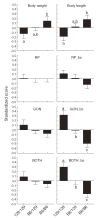A locus on mouse Chromosome 9 (Adip5) affects the relative weight of the gonadal but not retroperitoneal adipose depot
- PMID: 17103052
- PMCID: PMC1698868
- DOI: 10.1007/s00335-006-0055-1
A locus on mouse Chromosome 9 (Adip5) affects the relative weight of the gonadal but not retroperitoneal adipose depot
Abstract
To identify the gene or genes on mouse Chromosome 9 that contribute to strain differences in fatness, we conducted an expanded mapping analysis to better define the region where suggestive linkage was found, using the F(2 )generation of an intercross between the C57BL/6ByJ and 129P3/J mouse strains. Six traits were studied: the summed weight of two adipose depots, the weight of each depot, analyzed individually (the gonadal and retroperitoneal depot), and the weight of each depot (summed and individual) relative to body size. We found significant linkage (LOD = 4.6) that accounted for the relative weight of the summed adipose depots, and another for the relative weight of the gonadal (LOD = 5.3) but not retroperitoneal (LOD = 0.9) adipose depot. This linkage is near marker rs30280752 (61.1 Mb, Build 34) and probably is equivalent to the quantitative trait locus (QTL) Adip5. Because the causal gene is unknown, we identified and evaluated several candidates within the confidence interval with functional significance to the body fatness phenotype (Il18, Acat1, Cyp19a1, Crabp1, Man2c1, Neil1, Mpi1, Csk, Lsm16, Adpgk, Bbs4, Hexa, Thsd4, Dpp8, Anxa2, and Lipc). We conclude that the Adip5 locus is specific to the gonadal adipose depot and that a gene or genes near the linkage peak may account for this QTL.
Figures



Similar articles
-
Quantitative trait loci for individual adipose depot weights in C57BL/6ByJ x 129P3/J F2 mice.Mamm Genome. 2006 Nov;17(11):1065-77. doi: 10.1007/s00335-006-0054-2. Epub 2006 Nov 10. Mamm Genome. 2006. PMID: 17103053 Free PMC article.
-
Adiposity QTL Adip20 decomposes into at least four loci when dissected using congenic strains.PLoS One. 2017 Dec 1;12(12):e0188972. doi: 10.1371/journal.pone.0188972. eCollection 2017. PLoS One. 2017. PMID: 29194435 Free PMC article.
-
Loci on chromosomes 2, 4, 9, and 16 for body weight, body length, and adiposity identified in a genome scan of an F2 intercross between the 129P3/J and C57BL/6ByJ mouse strains.Mamm Genome. 2003 May;14(5):302-13. doi: 10.1007/s00335-002-2170-y. Mamm Genome. 2003. PMID: 12856282 Free PMC article.
-
Gender-influenced obesity QTLs identified in a cross involving the KK type II diabetes-prone mouse strain.Mamm Genome. 1999 Oct;10(10):963-8. doi: 10.1007/s003359901141. Mamm Genome. 1999. PMID: 10501964
-
A meta-analysis of quantitative trait loci associated with body weight and adiposity in mice.Int J Obes (Lond). 2007 May;31(5):829-41. doi: 10.1038/sj.ijo.0803473. Epub 2006 Oct 24. Int J Obes (Lond). 2007. PMID: 17060928 Review.
Cited by
-
Burly1 is a mouse QTL for lean body mass that maps to a 0.8-Mb region of chromosome 2.Mamm Genome. 2018 Jun;29(5-6):325-343. doi: 10.1007/s00335-018-9746-7. Epub 2018 May 8. Mamm Genome. 2018. PMID: 29737391
-
Genotype X diet interactions in mice predisposed to mammary cancer. I. Body weight and fat.Mamm Genome. 2008 Mar;19(3):163-78. doi: 10.1007/s00335-008-9095-z. Epub 2008 Feb 20. Mamm Genome. 2008. PMID: 18286334
-
Quantitative trait loci for individual adipose depot weights in C57BL/6ByJ x 129P3/J F2 mice.Mamm Genome. 2006 Nov;17(11):1065-77. doi: 10.1007/s00335-006-0054-2. Epub 2006 Nov 10. Mamm Genome. 2006. PMID: 17103053 Free PMC article.
-
Panx3 links body mass index and tumorigenesis in a genetically heterogeneous mouse model of carcinogen-induced cancer.Genome Med. 2016 Aug 9;8(1):83. doi: 10.1186/s13073-016-0334-8. Genome Med. 2016. PMID: 27506198 Free PMC article.
-
Genetic identification of Ly75 as a novel quantitative trait gene for resistance to obesity in mice.Sci Rep. 2018 Dec 5;8(1):17658. doi: 10.1038/s41598-018-36073-0. Sci Rep. 2018. PMID: 30518881 Free PMC article.
References
-
- Arbet–Engels C, Tartare–Deckert S, Eckhart W. C-terminal Src kinase associates with ligand-stimulated insulin-like growth factor-I receptor. J Biol Chem. 1999;274:5422–5428. - PubMed
-
- Baghaei F, Rosmond R, Westberg L, Hellstrand M, Eriksson E, et al. The CYP19 gene and associations with androgens and abdominal obesity in pre-menopausal women. Obes Res. 2003;11:578–585. - PubMed
Publication types
MeSH terms
Associated data
- GDB/DQ240818
- GDB/DQ240819
- Actions
- Actions
Grants and funding
LinkOut - more resources
Full Text Sources
Molecular Biology Databases
Miscellaneous

